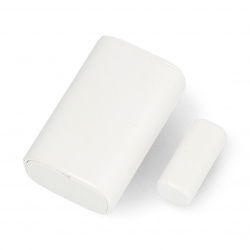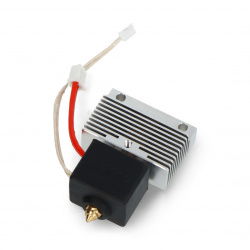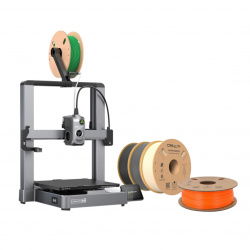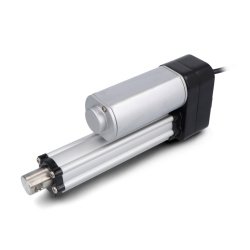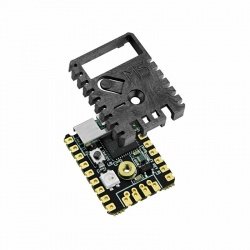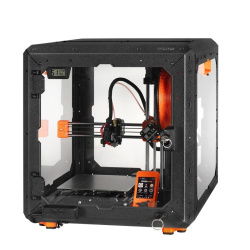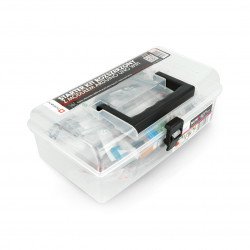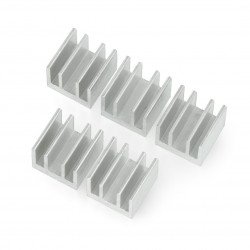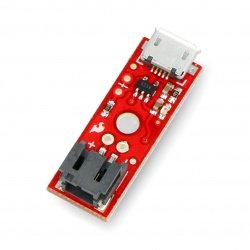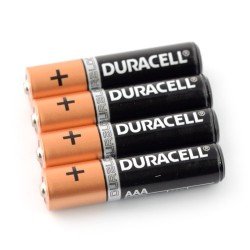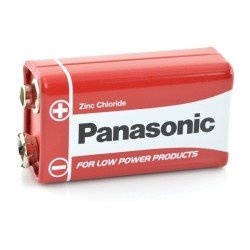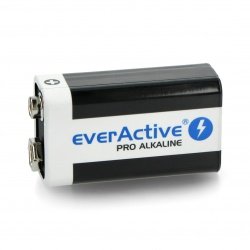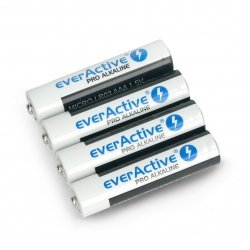Electrical devices need energy and thus a power source to function properly. There are many possibilities of supplying it, among them batteries, which is the simplest way to power a device. This of course applies to mobile and portable devices, which we use not always where we have access to the socket and mains power. Batteries can be found both in the remote control for TV, as well as in children's toys and remote-controlled vehicles, as well as electronic devices and controls for larger and more complex systems. Batteries differ not only in appearance but also in parameters. Not every battery fits all electronic devices. Therefore, it has to be properly adjusted to the requirements of the device. We have a choice of, among others, commonly known fingers, lozenges, i.e. flat batteries used most often in watches, as well as batteries for special purposes, e.g. for smart watches and smartphones.
EverActive Pro Alkaline 6LR61 9V alkaline battery
EverActive 6LR61 alkaline battery with a nominal voltage of 9 vol ts. Battery dimensions are 25.5 x 17 x 48 mm .EverActive Pro AAA (R3 LR03) alkaline battery - 4pcs.
Alkaline battery AAA (R3) - The popular small stick, with a nominal voltage of 1.5 V . Price per 4 pieces .See also
Which batteries should I choose?
The Botland store offers AA (R6) size batteries - common "fingers" are used to power many devices such as remote controls, toys, wall clocks, central heating furnace controllers, doorbells and alarm sensors. The AA battery is also used to power other equipment and is used in measuring devices, cameras and cameras. Additionally, AA batteries impact the daily lives of many people who use portable devices
In turn, AAA (R3) batteries – the so-called "little fingers" are used to efficiently power small portable devices. Our offer also includes batteries for bicycle lighting; D (R20) for powering robots, starting devices, modeling starter boxes and other wireless devices with high current consumption, as well as 9V 6F22 flat batteries used to power, among others, Walkie-Talkie sets, meters and guitar effects. In addition, we also offer coin batteries for powering wrist watches and maintaining memory settings, as well as specialized batteries of non-standard sizes for powering e.g. cameras or car remote controls.
Battery technology – what is worth paying attention to?
Batteries are an electrochemical voltage source. This means that the electricity drawn from the battery is the result of chemical reactions taking place in its internal structure. The oldest type of ordinary batteries is the zinc-carbon cell. It has a high internal resistance and is a good power source for low-power devices such as small radios, toys and pocket flashlights. At low temperatures, they are not very efficient, and at too high temperatures they tend to dry out the electrolyte easily. The zinc-chloride cell is characterized by half the battery's electrical capacity compared to the zinc-carbon cell, higher current efficiency and much lower leakage resistance, which positively affects its service life and ability to work at low temperatures.
Popular alkaline batteries (AA batteries and AAA batteries) - basic information
Finally, alkaline batteries (used, among others, in electronic devices), whose single cell capacity corresponds to the capacity of five zinc-carbon cells. Long service life , high efficiency , capacity loss of only 5% per year and zero content of harmful mercury and cadmium are the advantages of these batteries. Lithium batteries, on the other hand, have a significantly enhanced energy storage density, a negligible voltage drop with high battery current efficiency, a long service life and a capacity loss of only 0.5% per year. AAA (called little fingers) and AA batteries are the most commonly used cells that are universally applicable and can be used intensively.
Good batteries - high efficiency and environmental protection
Good batteries have advantages such as long life, high efficiency, low price and the least harmful impact on the natural environment. When choosing batteries for the device you want to power it with, pay attention to the size of the battery that fits it - very often this information is provided on the device's casing or in its battery container and in the device's user manual. These may be popular finger batteries or another type of power supply.
Used batteries – what to do with them?
Compared to rechargeable batteries, non-rechargeable batteries are characterized by greater durability and lower purchase costs. Remember that after using up batteries, do not throw them into mixed waste, but transfer them to dedicated containers - batteries contain poisonous heavy metals such as lead, mercury, cadmium or nickel. By returning used batteries to designated collection points, you protect the environment. Battery types must always be matched to a specific device (including size, shape and type of battery as well as voltage, current and capacity). Modern batteries available in our store ensure longer operation time of powered devices, toys and accessories.
Lithium-ion batteries are usually characterized by high energy density and very high discharge currents, which allows them to be used in devices with high demand for power supply, e.g. mobile robots . Lithium-polymer cells and packs are better suited for portable devices - they are produced in various sizes (often surprisingly small in thickness), have a lower level of self-discharge and are light in weight.
The battery stores energy in chemical form, thanks to which it can release the accumulated charge longer, but it does not allow recharging (as is the case with batteries ). Capacitors work by creating an electric field between the plates, which allows for very quick charging and discharging, but the amount of energy is incomparably lower than in the case of even a small battery.
The electrolyte contained in the batteries is quite a corrosive substance, so it can easily damage the plates and pressure springs that act as contacts in the battery baskets , and in some cases - by getting deep into the device's housing - it can lead to corrosion of other elements (e.g. tracks on the nearby printed circuit board). Contact with the skin, especially the eyes, may cause severe irritation and tissue damage, so batteries and the device "flooded" by them should always be handled very carefully.
Prolonged loading of the battery (or leaving it in an unused device for a long time) produces small amounts of gases, which are a product of the chemical reaction taking place inside such an energy source. Too much gas causes an increase in pressure, which in extreme cases may leak the battery. This phenomenon is also visible in the case of batteries , e.g. in mobile devices, and is caused by intense overload of the battery and operation at too high a temperature.
Small, conventional watches (hand and desk watches) usually use button batteries, e.g. alkaline or lithium. Larger devices (alarm clocks, wall clocks, etc.) are usually powered by R6 or LR6 "sticks".
The battery becomes unusable in three cases: when its voltage drops below a certain minimum value (e.g. 0.9..1.0 V for LR6 alkaline "sticks") when its housing is deformed (it is "swollen", mechanically damaged, etc.), or electrolyte leakage is visible (whitish coating near one of the poles).
In the case of popular 3-volt lithium batteries (e.g. CR2032), the threshold voltage (meaning complete discharge) is approximately 2.0 V - remember that this point may be reached after various operating times of the device, depending on the type of load .































































































































































































































































































































